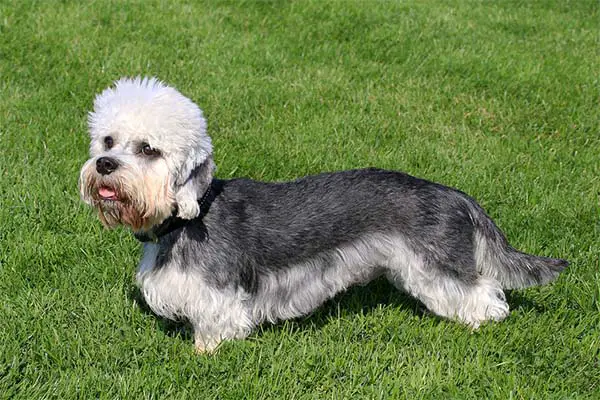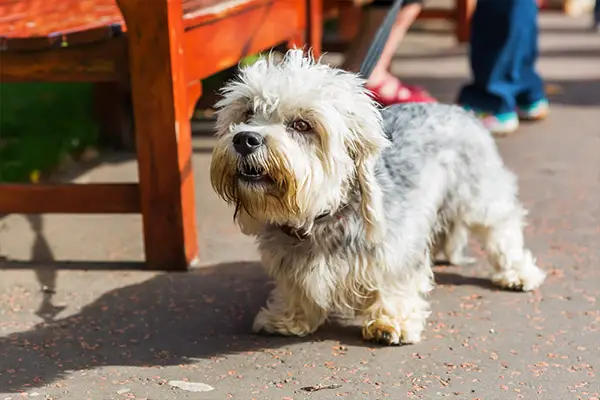The Dandie Dinmont Terrier is a small-sized dog that looks a bit different from other terrier breeds. These dogs feature a long body and large head covered with medium-length coats, long, feathery ears, and bright, round eyes.
The coats usually come in colors that range from black to pale gray or red to fawn. And their distinctive feature is the silky white top-knot on their heads.
Dandie Dinmont Terriers are known to be affectionate and lively family companions. If brought up well, they’ll get along with your children and other pets. They’ll be great playmates, but of course, supervision is always essential.

Dandie Dinmont Terrier Statistics
| Dog Breed Group | Terrier |
| Breed Size | Small |
| Height | 8-11 inches |
| Weight | 18-24 pounds |
| Lifespan | 12-15 years |
Dandie Dinmont Terrier Ratings
| Energy level | |
| Exercise needs | |
| Requires attention | |
| Playfulness | |
| Trainability | |
| Shedding | |
| Grooming | |
| Friendly with family | |
| Friendly with kids | |
| Friendly with strangers | |
| Friendly with other dogs | |
| Prey Drive |
History
Dandie Dinmont Terriers originated from Scotland around the 1700s. If you find their name interesting, it’s because it came from a fictional character in a book written by Sir Walter Scott.
The breed has served farmers for years, mainly for hunting small game and tracking otters. They are even considered one of the oldest breeds of terriers, but they don’t have a name. That was until Scott mentioned them in his book.
Scott is a famous novelist in Scotland who happens to be a fan of the breed. In his 1815 novel called “Guy Mannering”, he included a character named Dandie Dinmont. Dandie Dinmont is a farmer who keeps a pack of terriers who closely resembles the breed.
Due to this exposure, the terriers were named Dandie Dinmont’s Terriers with the “s” dropped as years went by. By 1875, the Dandie Dinmont Terrier Club was formed in Scotland, followed by a written standard for the breed.
By the late 19th century, the Dandies became very popular in England with Queen Victoria owning one. Even the French King Louis Philippe kept several Dandies as part of his royal entourage.
When these dogs reached the US is unknown, but the American Kennel Club registered them by 1886. Sadly when the World War broke off, the breed almost went extinct, like many other dogs breeds.
But thanks to the efforts of several breeders, the dog was reestablished again by the early 1990s. Today, they rank 176th as the most popular dog breed in the US and is also considered one of the rarest.
The England Kennel Club even listed the breed as endangered, and if not taken care of well, they might come close to extinction.

Temperament
Though considered one of the brightest among the terrier breeds, Dandie Dinmont Terriers are independent, smart, and proud dogs. These are hunters, so if you exercise him outdoors, make sure you have a securely fenced yard or put him on a leash.
These dogs will not be great companions for running or biking. They prefer long walks on a leash, play sessions, and family activities where you can include him.
Dandie Dinmont Terriers are known to be affectionate to their families. Most of the time, they only bond with a single person. As they are naturally calm indoors, they’ll make excellent companions for children too.
They are mostly reserved with strangers. You’ll also appreciate the fact that these dogs are not barkers. They are determined watchdogs, though, and you can expect them to bark when necessary.
They are also usually friendly with other dogs and don’t try to act dominant. However, they also won’t back down if pushed.
Though calmer than most terrier breeds, Dandies need early socialization to become more well-rounded dogs. This will also help them become more accustomed to anything new, making it easier for them to manage their feelings.
These dogs are also known to have a mind of their own. They need consistent and firm leadership. Make sure to carry lots of patience, though, and it’s important not to be harsh on this dog as this will only make them more uncooperative.
Dandie Dinmont Terrier Care Requirements
- Nutrition: Dandie Dinmont Terriers require nothing but high-quality and well-balanced meals daily. Proteins, fats, carbohydrates, vitamins, and minerals are most important. So, if you’re serving home-cooked meals, make sure only to buy high-quality ingredients that contain these nutrients. Fruits and vegetables are great to add to your dog’s meals. Other than vitamins, fruits and vegetables can also provide fiber, which helps a lot with dog’s digestion. Take note of any ingredient your dog is allergic to, as well, and make sure to stay away from those. For dog foods and dog treats, buy premium-quality products. If possible, make sure that it doesn’t contain fillers, additives, and by-products. These ingredients have low-nutritional value and will not benefit your dog. Watch the daily calorie intake of your dog as well. We advise that you ask your vet about this so he can create a feeding guide specific to your dogs based on the age, activity level, and metabolism.
- Grooming: The Dandie Dinmont Terriers’ coats are a combination of soft and hard hairs. These dogs don’t shed much, but that doesn’t mean that there would be no grooming required. It’s recommended to strip your dog’s hair a couple of times in a year, so it stays neat and clean. Brushing is also essential to help prevent matting, then pluck the long hairs for an even look. You may do this yourself, but we highly recommend taking them first to a professional groomer and learning it from them. This way, you ensure that you’re doing the right thing. Baths can be given occasionally, depending on how much your dog needs it. Ears should be cleaned regularly, though. Don’t also forget your dog’s nails, and make sure that it stays short.
- Exercise: Dandie Dinmont Terriers are generally calm dogs indoors, but they do need their exercise to stay fit and healthy. Usually, they only require 30 minutes of exercise twice a day. This could be in the form of brisk walks or just let them run in your yard. Ensure that you have a securely fenced yard, and keep them on a leash during your walks. These dogs are hunters and will chase the first prey they see. You can’t take them out to run for long distances, for jogging, or biking. Their bodies are not built for this, and this might only cause problems to their muscles.
- Health: Dandie Dinmont Terriers are generally healthy dogs with a long lifespan. But just like with any other dog breeds, there are certain health conditions they might get in their lifetime. Hip and elbow dysplasia, hypothyroidism, von Willebrand’s disease, thrombopathia, and eye diseases are common. It’s highly recommended to have your dog take some screening tests to detect these diseases early. You should also watch out for the following:
- Glaucoma
- Cheyletiella yasguri mites
- Spinal problems
- Epilepsy
- It’s always best to meet at least one of your dog’s parents to be aware of hereditary diseases your dog might acquire. Closely monitor your dog’s behavior, too, and if there are any changes, don’t forget to take them to the vet.
- Lifespan: The life expectancy of Dandie Dinmont Terrier is 12-15 years.
Famous Dandie Dinmont Terriers
- Bonnie Britton: The first Dandie Dinmont registered by the American Kennel Club
- Old Ginger: The foundation of all Dandie Dinmont Terriers today
- Old Mustard, Young Pepper, Young Mustard, Little Pepper, Little Mustard, and Old Pepper: The immortal six, James Davidson’s dogs
Fun Facts about Dandie Dinmont Terriers
- Dandie Dinmont Terriers originated from Scotland around the 1700s.
- They are the only dog breed to be named after a fictional character.
- They are believed to be close relatives of the Bedlington Terrier.
- They were bred for hunting (particularly otter tracking).
- These dogs are in danger of extinction.
- They were recognized by the American Kennel Club in 1886.
Check Out Other Terrier Dog Breeds:
Airedale Terrier, American Hairless Terrier, American Staffordshire Terrier, Australian Terrier, Bedlington Terrier, Border Terrier, Bull Terrier, Cairn Terrier, Cesky Terrier, Glen of Imaal Terriers, Irish Terrier, Kerry Blue Terrier, Lakeland Terrier, Manchester Terrier, Miniature Bull Terrier, Miniature Schnauzer, Norfolk Terrier, Norwich Terrier, Parson Russell Terrier, Rat Terrier, Russell Terrier, Scottish Terrier, Sealyham Terriers, Skye Terrier, Smooth Fox Terrier, Soft Coated Wheaten Terrier, Staffordshire Bull Terrier, Welsh Terrier, West Highland White Terrier, Wire Fox Terrier
